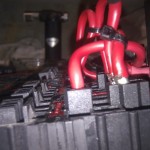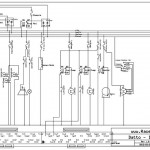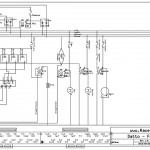Since I started with the wiring on the car and especially while busy with the relay/fuse box, I realised why so many people hate wiring, it is properly the most time consuming piece of work you will ever do on a project, well definitely if you have nothing to work from and not scared for doing a job off it that you can be proud of. One thing that came to mind was how does a auto electrician that really does a neat job charge his clients, there is no way in hell I would’ve been able to afford the time it took to get my wires to the point where it is currently if I had to pay someone to do the job. It just takes to damn long, well since the car is back home, I enjoy working on it a lot more, it is now a hoppy, every joint I solder is fun and done in no hurry. I think my girlfriend had more of my time when the car was at my parents, at least she had some of my attention during the week. Anyway back to the work at hand.
I don’t know why I started with the relay/fuse box, maybe because the majority of the wires was pulled in and waiting for the it. The main wires running to it from the cut-out switch was replaced with a thicker gauge wire as I intend using two sets of spotlights on the car running anything between 100-150W globes. Overkill you may think, hell yes, I can’t agree with you more, but I just like an old rally car with its 2-4 spotlights on, if ever I get the opportunity to display the car somewhere, it will most properly be with the spots. As things currently stand with rallying in the Cape, I don’t think it would take me long to enter the car in a Rally Sprint. In fact I’ll marshal at the 2012 Witzenberg Ceres Rally Sprint, before you want to throw glasses on my for not want to work on the car, it’s all a part of the bigger picture, I want to go and have a look at the conditions, atmosphere etc. of these sprints, from the organizing/official side, it is a nice bunch of people making these possible, why not slap a set of other springs on the car, lift it by a mile and go have some fun on gravel. Rallying is a dream, just maybe I can try it with this car, all the work done by my father and I sure as hell is strong enough to make it to the end of at least one sprint.
OK, back to wires. The first thing i did was figure out the way I want the layout to be of the Relay/Fuse box, easiest and most logical way I could come up was chassis on the right, fuses in the middle and ECU related on the left, let me explain. I’m running two separate feed wires from the cut-out switch to two main fuses, one for ECU and the other for Chassis related functions, these fuses then supply the fuses with power, but before the power reaches the fuses, it is switched via two main 70A relays which is triggered by the ignition switch. The logic behind this is as follows. After a lot of discussions regarding a alternator feeding the motor with power in the event that the cut-out switch has been disconnected, the above is my answer to the problem, this way all power around the car is controlled from a central point, being the relay/fuse box, in the event that the cut-out switch is disconnected, the main relays immediately loses power and opens, thus no power not even power to the alternator, which renders it useless to generate additional power. Clever hay, not overkill again, but that is just me. My brother also came up with the most brilliant idea called a switch fuse, this little bugger supply some of the switches with +12V with the ignition off, thus some of the relays can be triggered, but since the main relays is not energised, nothing will happen. Again if something goes wrong, the switch fuse will pop and render the circuits useless. Too much to try and explain in a few sentences. The main fuses is mounted just below the relay/fuse box to make managing the wires easier and neither, well at least those that will be visible.
Since the modular parts I use to construct the relay/fuse box did not have buzz bars, I had to make my own. These modular parts are very nice, you decide what you need and buy the individual components and build your own. Soon after I started with the distribution off power, I realised that I will need to label the different components. The main feed wires was done and then it became a mess, with trying to figure out what needs to go were. At this point I can motivate the use off a very handy, easy to use, free application called ExpressSCH with my limited electrical knowledge I figured the application out and started drawing the schematics, thus helped me allot in understanding the logic around the different circuits. Know you can start to understand why I said in the beginning that I cannot think what a job like this would have cost me. Any way the relay/fuse box is finished, just need to add the trigger wires and output wires.
During this whole wiring phase, the car actually went to Profit Exhaust for the branch and exhaust, but at least I was able to continue with the dash wiring. During the preparations for the branch, I noticed that I need a few additional Deutsch connectors to make life easier. One for the coils and some for the ignitors. The wiring for the dash kept me busy for quite some time and up to know it is not done yet, everything is in place, but still needs to be taped up and sleeved. While I was busy with the dash I noticed in my spread sheet that I have used +-350m off wire on the car, this excludes stuff like a 7 core cable for the rear lights and ECU wiring, not allot if you consider the amount of wires they use in modern cars, but sure as hell allot for a freak in 1972 Datsun.
More Pictures – 20 March 2012 – Wiring III
Return to Datsun 1200
















